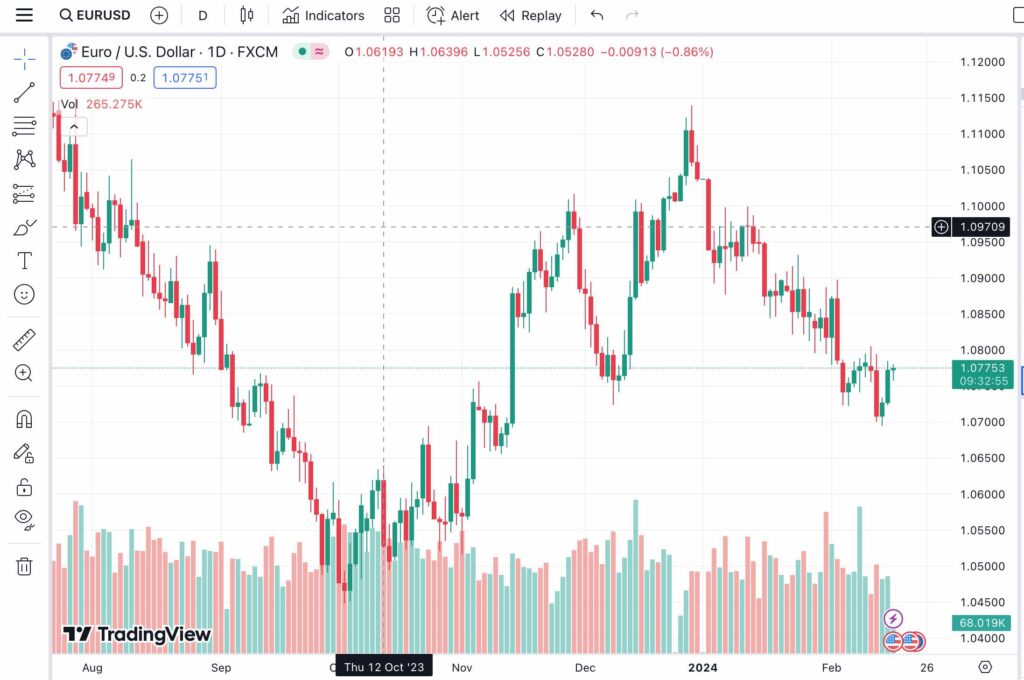When you’re trading the EUR/USD pair from Kenya, timing is everything. The forex market operates 24 hours a day during the weekdays, segmented into four major trading sessions:
- Sydney
- Tokyo
- London, and
- New York
These sessions correspond to the business hours of the world’s leading financial markets. The timing of these sessions varies throughout the year due to daylight-saving time adjustments in different countries.
At Kenya Forex Firm, we’ve meticulously tested and evaluated the best times to trade the EUR/USD currency pair, and here’s what you need to know.
Join the Copy Trading Revolution
Copy the trades of successful Forex traders and profit from their strategies.
*Forex and CFDs Trading involves high risk. T&Cs apply.
Best Time to Trade EURUSD in Kenya

The EUR/USD currency pair is most active when the market hours in New York and London overlap. For you in Kenya, this translates to the late afternoon and early evening hours, typically between 4:00 PM and 8:00 PM EAT (Kenyan time).
During this window, the trading volume spikes, which often leads to increased liquidity and tighter spreads – a favorable environment for traders like you.
Our evaluation process for the best time to trade forex involves:
- Analyzing historical data
- Monitoring pip movements, and
- Keeping a close eye on the economic calendar.
We’ve noticed that the highest volatility on the EURUSD tends to occur in the middle of the week, from Tuesday to Thursday. This is when you should be particularly attentive, as major economic announcements from Europe and the United States can create significant opportunities for profit.
However, it’s not just about the when; it’s also about the how. At Kenya Forex Firm, we advocate for a strategic approach. You should consider both technical analysis and fundamental factors when planning your trades.
Keep an eye on key economic indicators such as interest rate decisions, employment reports, and GDP figures, as they can heavily influence the EUR/USD market.
Here’s a curated list of the best times to trade EUR/USD from Kenya, using a combination of market overlaps and economic release schedules:
- European Market Hours (GMT+3) Opening Hours: The European forex market opens at 10:00 AM Kenyan time (GMT+3). This is when the London session starts, leading to increased liquidity and volatility, making it a prime time for trading EUR/USD.
- London Session Overlap with New York Session: The best trading window for the EURUSD is during the London-New York overlap from 3:00 PM to 7:00 PM Kenyan time. This period sees the highest liquidity and volatility, as the American session opens at 3:00 PM Kenyan time.
- US Economic Releases NFP and CPI Release Times: The Non-Farm Payroll (NFP) report and Consumer Price Index (CPI) releases are pivotal for the USD. These are typically published at 3:30 PM Kenyan time, except during Daylight Saving Time when it’s at 4:30 PM. Trading around these releases can be profitable due to the volatility they introduce, but it’s also riskier.
- ECB Announcements Interest Rate Decisions and Press Conferences: The European Central Bank’s (ECB) interest rate decisions and subsequent press conferences can significantly impact the EUR/USD pair. These events usually occur around 2:45 PM Kenyan time for the announcement and 3:30 PM for the press conference. Dates vary, so checking the ECB’s calendar is crucial.
- Economic Data Releases Eurozone Economic Releases: Key Eurozone indicators, such as GDP, unemployment rate, and manufacturing PMIs, can also affect the EUR/USD. These are typically released in the morning hours (GMT+3), making the period from 10:00 AM to midday another critical window for traders in Kenya.
-
Trading EURUSD During the London-New York Overlap
To make the most out of the London-New York overlap, you should consider employing strategies that leverage the increased market activity.
Scalping and day trading are particularly effective, as they allow you to take advantage of the rapid price movements.
Related Article: Asian Session Forex Time in Kenya
-
Is it Good to Trade EURUSD During Major News Releases
When it comes to trading the EUR/USD currency pair, major news releases like the Consumer Price Index (CPI) and the Nonfarm Payrolls (NFP) can significantly impact market volatility and trading dynamics.
The CPI and NFP are among the most closely watched economic indicators in the forex market.
- The CPI measures inflation, while the NFP reports on the number of jobs added or lost in the U.S. economy, excluding farm employees.
Both indicators provide insights into the economic health of the Eurozone and the United States, respectively, and can lead to substantial price movements in the EUR/USD pair.
- The Nonfarm Payrolls (NFP) report is released by the U.S. Bureau of Labor Statistics and is part of the Employment Situation report published on the first Friday of each month, typically at 8:30 AM Eastern Time. Considering the time difference, when it is 8:30 AM in New York, it is generally 3:30 PM in Nairobi, Kenya, during the periods when the U.S. is on Eastern Standard Time (EST). However, during Daylight Saving Time (DST) in the U.S., when clocks are set forward by an hour, the release time shifts to 4:30 PM EAT in Kenya.
Trading EURUSD During CPI and NFP Releases
- Volatility: The release of CPI and NFP data can lead to increased volatility in the EUR/USD pair. Traders often witness heightened market activity as these reports can cause rapid price fluctuations. For instance, a higher-than-expected NFP figure could strengthen the USD, leading to a decline in the EUR/USD pair, and vice versa.
- Opportunities and Risks: High volatility during major news releases presents both opportunities and risks. Traders can capitalize on quick price movements to make profits. However, the unpredictability of market reactions to news releases also increases the risk of losses. Always have a solid risk management strategy in place, including the use of stop-loss orders to protect against adverse market movements.
- Market Sentiment: The anticipation and reaction to CPI and NFP data can also influence market sentiment. Traders often adjust their positions ahead of these releases based on their expectations. Unexpected data outcomes can lead to swift changes in market sentiment, affecting the EUR/USD trading dynamics.
- Strategies for Trading EURUSD During News Releases: Traders employ various strategies when trading EUR/USD around major news releases. Some prefer to position themselves before the news, anticipating the market direction, while others may wait for the news to be released and trade based on the market’s reaction. Both approaches require a thorough analysis of the news and its potential impact on the market.
Avoid Trading the EUR/USD During the Asian Session
During the Asian session, the market’s focus shifts towards currencies more geographically relevant to that time zone, such as the Japanese Yen (JPY) and the Australian Dollar (AUD).
As a result, major currency pairs involving the Euro (EUR) and the US Dollar (USD) experience lower liquidity. Lower liquidity means fewer participants in the market, which can lead to larger spreads and less favorable trading conditions.
One of the primary drawbacks of trading the EUR/USD during the Asian session is the lack of liquidity. During the Asian session, the EUR/USD pair tends to experience lower liquidity due to the reduced number of active traders. This can lead to wider spreads and increased volatility, making it challenging to enter or exit trades at favorable prices.
Liquidity refers to the ease with which an asset can be bought or sold without significantly impacting its price. With lower liquidity, it becomes more challenging to execute trades at desired prices, and the bid-ask spreads tend to widen, increasing the cost of trading.
The Asian Session is, however, not all doom and gloom! It can still offer opportunities, especially if you’re trading other currency pairs or instruments more closely tied to the active economies during this period.
For instance, pairs like AUD/USD, NZD/USD, or USD/JPY might provide better trading conditions. Click here to learn more about the Asian Session Forex Time in Kenya.
-
Pros of Trading EURUSD During News Releases
- Increased Volatility: These releases can create significant price movements, offering the potential for quick profits if the market moves in your favor.
- Opportunity for Scalpers and Day Traders: Traders who thrive on short-term strategies may find these periods particularly lucrative due to the rapid price changes.
-
Cons of Trading EURUSD During News Releases
- Higher Risk: The increased volatility can also mean greater risk, as the market can move against your position just as quickly.
- Spread Widening: Brokers often increase spreads during times of high volatility, which can eat into potential profits.
- Predictability: While these reports can lead to significant market movements, predicting the direction of these movements can be challenging, even with thorough analysis.

